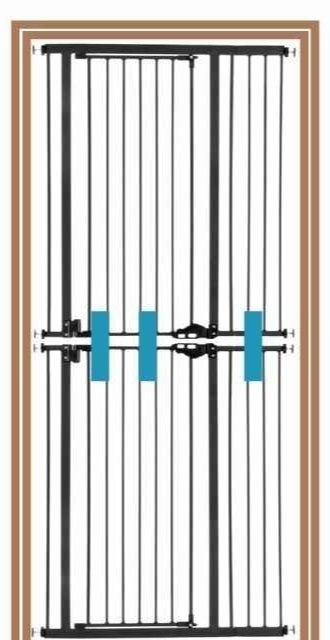How to keep your cat and dog separated (beyond doors and baby gates)
You need ways to keep your cats and dogs separate from each other while you aren't supervising them, even if you don't have any concerns about their safety when left alone. This calls for a solid management plan!
Since you're actively working on improving their relationship, you want to make sure they don't annoy each other or stress each other out if you aren't there to intervene or redirect.
Your main goal is to keep them physically apart, but you might also need to block sightlines to keep the peace...
So how do you make that happen?
Options for Management Tools
Adjust the tension of the top gate so it stays unlatched (to make it easier for you to walk through) - you only have to latch the bottom gate since the “doors” are connected!
doors (solid, screens when appropriate - if your animals are able to see each other without getting triggered)
if one or more of your pets likes to put their paws underneath doors, you can block that gap off with a towel or small rug
baby gates (ideally bolted to the wall, tall, vertical slats, with "doors" for you to easily enter and exit)
you can attach foam core or poster board to block visual access, you can also cover a gate with a blanket if your animals don't try to shift the blanket to peek
vertical slats prevent successful climbing up and over, bolted to the wall prevents animals from pushing the gate over
some pets can jump over even the tallest baby gates, so you can try stacking them inside a doorway (download my free Gate Guide for in-depth instructions)
Attach a heavy-duty blanket to the top of each panel using zip ties or velcro (but this is not nearly as secure as a crate, so don’t use this setup for true escape artists).
exercise pens (x-pens) with "lids" to prevent climbing up and over, might need to attach it to heavy furniture or the wall so the animal inside can't push it around the room
crates/enclosed cat condos
covered with a blanket or sheet is a way to add a visual barrier, or you can use a tri-fold presentation board (like from your elementary school science fair projects) if crate is placed in a corner
muzzles (especially for dogs with bite histories to smaller animals) - you want a basket muzzle that your dog can eat, drink, pant, and take treats in (check out the Muzzle Up! Project for good info)
comfortable back clip harness with a leash tethered to a heavy piece of furniture or to you (only when supervised by you directly - never leave a tethered animal alone, they could get caught in the leash and get seriously hurt)
Important considerations when choosing management tools
the layout of your house (e.g. x-pens are good for open floor plans)
the habits or views of the humans in the house (baby gates are often left open by young children, your partner might not be comfortable with a crate)
the physical capabilities and habits of each animal (some cats don't jump baby gates, others don't think twice) - keep in mind that these can change (a fat cat can lose enough weight to sneak through the slats of a baby gate, a kitten might get bold enough to try to jump over)
Double up!
Any given management tool will always fail at some point, so it's best to be prepared. Make sure there are two layers of management at any given spot to ensure that your animals won't accidentally get to each other. You can try:
having your dog muzzled while your cat is behind a baby gate
your dog in a crate with your cat behind a screen door
dog behind a baby gate with your cat in a condo/enclosure




